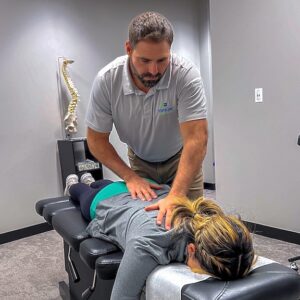Sciatica, characterized by excruciating pain radiating from the lower back down through the legs, can significantly impede one’s daily life. Amid various treatments, chiropractic care emerges as a vital avenue for managing sciatica and preventing its complications. Chiropractor Near Me, with their specialized services, offer a holistic approach that can alleviate sciatic pain and avert potential complications.
Understanding Sciatica and Its Implications
Sciatica occurs due to compression or irritation of the sciatic nerve, often resulting from spinal misalignment, disc herniation, or muscle spasms. This condition can cause not only intense pain but also weakness, tingling sensations, and numbness along the nerve’s pathway. If left unaddressed, sciatica can lead to debilitating complications and impact one’s quality of life.
How Chiropractic Services Target Sciatica
Chiropractors employ a range of techniques tailored to alleviate sciatic pain. Through spinal adjustments, they aim to realign the spine and reduce pressure on the affected nerve, providing relief from the pain and discomfort associated with sciatica. Additionally, chiropractic care often includes exercises, stretches, and lifestyle recommendations to support spinal health and prevent future sciatica flare-ups.
Chiropractic care provides a multifaceted approach to address the complexities of sciatica. Chiropractors employ a variety of specialized techniques and treatments designed to specifically target the root causes of sciatic nerve irritation and alleviate associated discomfort.
Spinal Adjustments:
Central to chiropractic care for sciatica are spinal adjustments, also known as spinal manipulation. Chiropractors use their hands or specialized instruments to apply controlled and precise force to the vertebrae in the spine. These adjustments aim to correct misalignments (subluxations) in the spine, particularly in the lumbar (lower back) region, which could be contributing to the compression or irritation of the sciatic nerve.
By realigning the spine, chiropractors seek to reduce the pressure on the sciatic nerve, thereby alleviating the pain, tingling, and numbness often associated with sciatica. These adjustments are tailored to the individual’s specific condition and are performed with careful consideration of the patient’s comfort.
Mobilization and Stretching:
Chiropractors often complement spinal adjustments with various mobilization techniques and targeted stretches. These techniques are aimed at improving the flexibility and mobility of the affected areas. By mobilizing the spine and surrounding muscles, chiropractors strive to reduce tension and enhance the body’s natural healing process.
Exercise and Rehabilitation:
Chiropractic care for sciatica may also involve recommending specific exercises and rehabilitation programs. These exercises focus on strengthening the muscles that support the spine and improving overall posture. Strengthening these muscles can provide better stability to the spine, reducing the likelihood of recurrent sciatic nerve irritation.
Lifestyle Modifications:
Chiropractors offer guidance on lifestyle modifications to mitigate sciatica symptoms and prevent future flare-ups. This can include ergonomic advice for workstations, proper lifting techniques, and suggestions for maintaining a healthy weight. Lifestyle modifications are integral to preventing the recurrence of sciatica by reducing stress on the spine and supporting its proper alignment.
Holistic Approach:
Chiropractors take a holistic approach to address sciatica, considering not just the symptoms but also the overall well-being of the patient. They may offer nutritional advice, stress management techniques, and other supportive measures to enhance the body’s ability to heal itself and maintain spinal health.
Soft Tissue Therapy:
Soft tissue therapy, such as massage or IASTM, is a cornerstone of chiropractic care for sciatica. Massage techniques involve manipulating soft tissues to reduce muscle tension and enhance blood flow to affected areas. IASTM employs specialized tools to break down scar tissue and adhesions that may contribute to nerve compression. By focusing on the muscles around the affected area, these therapies complement spinal adjustments, promoting relaxation, pain relief, and improved mobility.
Nerve Flossing:
Nerve flossing exercises are gentle, controlled movements designed to relieve tension along the sciatic nerve. Chiropractors guide patients through specific exercises that aim to reduce nerve irritation caused by compression. These exercises involve controlled stretching and movement patterns that gently glide the nerve through its pathways, potentially easing pain and enhancing the nerve’s ability to function properly.
Postural Correction:
Posture plays a significant role in spinal health and sciatica management. Chiropractors assess a patient’s posture to identify imbalances or misalignments that could contribute to sciatic nerve compression. They offer guidance on correcting posture during daily activities, including sitting, standing, and lifting. Proper posture reduces stress on the spine and nerves, supporting spinal alignment and potentially preventing future sciatica episodes.
Traction:
Spinal traction techniques involve applying gentle force to the spine to create space between vertebrae. This method aims to relieve pressure on the spinal discs, reducing compression on the sciatic nerve. Traction can be beneficial for patients experiencing disc-related sciatica symptoms by promoting the rehydration of spinal discs and alleviating nerve compression, thereby reducing pain and discomfort.
Heat and Cold Therapies:
Heat and cold therapies are commonly utilized in chiropractic care to manage sciatic pain. Heat application through heating pads or warm compresses relaxes muscles, improves blood circulation, and helps alleviate muscle spasms. Cold therapy, typically using ice packs, reduces inflammation and numbs the affected area, providing temporary pain relief. Alternating between these therapies as advised by a chiropractor can effectively manage pain and support the healing process.
Heat and Cold Therapies:
Chiropractors empower patients by offering education on sciatica and guidance on self-care practices. They educate patients on proper body mechanics, ergonomic adjustments in daily activities, and specific exercises to strengthen core muscles and improve flexibility. Additionally, they may recommend self-massage techniques or tools to alleviate discomfort between chiropractic visits. Educating patients on self-care strategies fosters active participation in managing their sciatica and promotes long-term relief.
Custom Orthotics or Supports:
For individuals whose sciatica is influenced by foot or gait issues, chiropractors may suggest custom orthotics or supports. These customized devices aim to correct foot alignment, improve gait mechanics, and reduce stress on the lower back and sciatic nerve. By providing proper support and alignment, custom orthotics or supports can significantly alleviate pressure on the spine, contributing to long-term relief and preventing sciatica recurrence.
Role of Chiropractic Adjustments in Sciatica Management
Chiropractic adjustments serve as a cornerstone in the effective management of sciatica, playing a pivotal role in addressing the underlying issues that trigger this debilitating condition. The fundamental principle behind chiropractic care lies in rectifying spinal misalignments, which are often the primary culprits behind sciatic nerve compression and subsequent pain. Through the application of precisely directed force to specific areas of the spine, chiropractors meticulously manipulate vertebral structures to re-establish optimal alignment.
This meticulous realignment of the spine serves as a catalyst in relieving the pressure exerted on the sciatic nerve. As the misalignments are corrected, the undue stress on the nerve is alleviated, facilitating a reduction in the intensity and frequency of sciatic pain. By pinpointing and addressing these spinal misalignments, chiropractic adjustments not only tackle the symptoms but also target the root cause of the condition. This approach stands in stark contrast to merely masking the pain through medications, as it aims for long-term relief by addressing the origin of the problem.
Moreover, these adjustments trigger a chain reaction within the body, promoting its innate healing processes. When the spine is properly aligned, nerve function is optimized, allowing the body to function more harmoniously. This enhanced nerve function fosters improved communication between the brain and the affected areas, facilitating the body’s natural ability to heal itself. Consequently, the body’s recuperative mechanisms are activated, working towards repairing any damage caused and restoring overall well-being.
The significance of chiropractic adjustments in sciatica management lies not just in immediate pain relief but also in fostering a conducive environment for the body’s healing mechanisms to operate efficiently. By rectifying spinal misalignments and alleviating nerve pressure, chiropractic care goes beyond a mere symptomatic approach, striving to promote holistic wellness.
Preventing Sciatica Complications through Chiropractic Care
Persistent or recurrent sciatica can lead to complications such as chronic pain, muscle weakness, and decreased mobility. Chiropractors, with their expertise in spinal health, aim not only to alleviate immediate symptoms but also to prevent these potential complications. Regular chiropractic sessions may reduce the likelihood of sciatica progressing into more severe conditions.
Collaborative Approach for Effective Sciatica Management
Chiropractors recognize the multifaceted nature of sciatica and acknowledge the benefits of a collaborative approach to offer patients the most comprehensive care possible. Collaborating with various healthcare professionals, such as physical therapists, acupuncturists, orthopedic specialists, and pain management experts, allows chiropractors to devise a more integrated treatment plan. By combining chiropractic adjustments with complementary therapies, patients can access a broader spectrum of care aimed at addressing different facets of their condition.
Physical therapy, for instance, complements chiropractic care by focusing on exercises and stretches that strengthen muscles, enhance flexibility, and improve posture. This collaborative effort aids in correcting underlying musculoskeletal imbalances contributing to sciatic nerve irritation. Acupuncture, another adjunct therapy, targets pain relief by stimulating specific points on the body, potentially reducing sciatic pain and promoting relaxation. The combined effects of chiropractic adjustments alongside these complementary therapies create a synergy that can significantly enhance the overall effectiveness of sciatica management.
Moreover, this collaborative approach isn’t solely about treating the symptoms of sciatica; it’s about empowering patients to take charge of their well-being. Through education and guidance provided by a team of healthcare professionals, individuals suffering from sciatica can gain a deeper understanding of their condition. This knowledge equips them with tools and strategies to manage symptoms more effectively, make lifestyle adjustments that support spinal health, and prevent future sciatica flare-ups. The holistic nature of this collaborative care model fosters not only physical recovery but also empowers patients to actively participate in their healing journey.
Importance of Timely Intervention
Early intervention is crucial in preventing sciatica complications. Seeking chiropractic care as soon as symptoms manifest can potentially halt the progression of the condition and alleviate discomfort. Even if the pain is mild initially, consulting a chiropractor can prevent sciatica from worsening and leading to more severe issues.
Chiropractic treatment offers a non-invasive and drug-free approach to managing sciatica and preventing potential complications. Chiropractors, with their expertise in spinal health, aim to address the root cause of sciatic pain, providing relief and enhancing the body’s natural healing process.
For individuals experiencing sciatica or seeking preventive measures, consulting a chiropractor near you could be instrumental. Their specialized services, including chiropractic adjustments and personalized care plans, offer a promising avenue for sciatica relief and long-term well-being.
Chiropractic care near me, when integrated into a proactive healthcare routine, can help individuals regain mobility, reduce pain, and avoid the complications associated with sciatica.
Why Choose Us?
At Evolve Chiropractic of Woodstock, we prioritize patient well-being. Our clinic provides a warm and inviting environment where clients receive attentive care and personalized attention. From injury rehabilitation to ongoing wellness maintenance, our skilled practitioners are dedicated to helping clients achieve their health goals.
2440 Lake Shore Dr, Woodstock, IL 60098, United States
815-338-9150
https://myevolvechiropractor.com/locations/chiropractor-in-woodstock-illinois/





